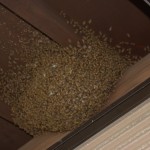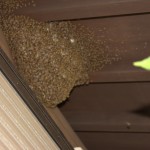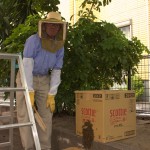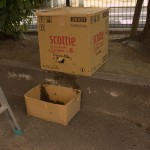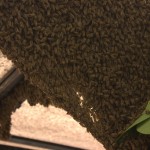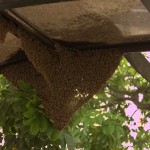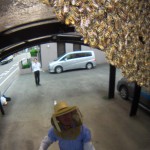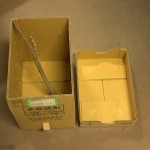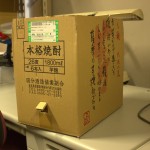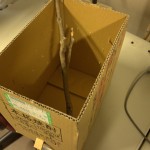Of course there can always be an alternative explanation for almost everything that happens, especially when one claims it is an answer to prayer, but I believe in the power of prayers and I would be remiss not to thank my God for his blessings to me. Let me explain why I start out writing this way. I lost all the hives of native Japanese honey bees I was able to collect last year, and I think it was mostly due to them getting too hot where I was keeping them on the cement roof of a building at the University. They received full sun in the morning and afternoon shade, but apparently that is not good enough because of how hot it got. So I have been “beeless” here in Japan for quite some time.
I was really hoping that this spring I would get some phone calls about honey bee swarms that I would be able to pick up and put in hives, and hopefully this time they would stay and not just abscond and fly away. The native bees are very wild and fickle and often leave the hive you think they would stay in. In the first place, though, I needed to find out where there were swarms, and as most people know, it is a very rare thing for one person to see a swarm of bees. Many if not most people have never seen a swarm of bees during their entire lifetime, unless they are a beekeeper or live near one. I found out through experience a long time ago that the best way to find swarms of bees is to figure out who people call to help them with the problem if they have a swarm of bees on their house or in their yard, and ask that office or person to contact me with the information so I could go pick up the bees. It works if there are enough swarms of bees and enough people calling at the times the bees are swarming, otherwise you don’t hear anything at all–the sounds of silence.
This spring, speaking to my friends that I knew were keeping the native honey bees, I found that their bees started swarming in March locally, but I received no phone calls for about a month after I knew bees were already swarming. I waited, expecting and hoping to receive some phone calls from the city health and welfare offices here in my city in Japan like I did last year. I even asked the other professor in my department who helped me last year to call the city offices again and remind them that we would still like to get calls about bee swarms. He did that for me, but still no calls. Finally I remembered the scripture that says, “Ask and ye shall receive,” and not just ask anyone, but ask God. I therefore started praying that I would get some phone calls and be able to get some bees into my hives as a result this spring. I prayed sincerely and from my heart that if my prayer was not in opposition to God’s will for me, that I would receive some calls for bee swarms. It was not until after I prayed and asked for God’s intervention that I started receiving phone calls and was able to collect some bee swarms. I also prayed that the bees would stay in the hives where I put them and not leave. Thankfully, they have stayed. Believe it or not, I have now been able to collect 5 swarms of the native bees this spring. One was last week and two were this week. On top of that, the last 3 have all been very close by my office at the university.
On Tuesday of this week, I received a call from a location that is just a few blocks away from the campus where I work. One of the students drove me and Kamitani sensei to the location, but when we arrived, we found out that the swarm had flown away just a little while before we arrived. That happens sometimes and was very disappointing, but sometimes it is for a good reason (at least I can think of some good reasons in hindsight). It’s usually best not to get too upset about things you don’t have any control over and try to second guess yourself. The people at the house where the bees left asked us for our business cards and we gave them our cards. On Thursday, the same people called from the same house and said another swarm of bees had come and was on the underside of the eave of their house.
There was no car available this time, so Kamitani sensei and I rode our bicycles there right before lunch, and I took my protective gear (hat, veil, and gloves) along with a swarm collection box, and using a ladder that they had there, I collected the bees into the box and set it on top of the ladder to let the remainder of the bees that I had not caught in the first try to join those in the box. After putting the lid on the box, I left a small trap door open so the rest of the bees could find the swarm by smell and join them in the box. If the queen is inside, the worker bees almost invariably will join and go in too. Otherwise they will all leave the box and go back to wherever the queen is. I went back after lunch to check on them and there were still many bees that had not joined the box, so I decided to leave it there and return later. I phoned my friend, Shiki san, and he had time and was willing to drive his truck out to the university and pick up me, my bicycle and the bees. I had decided to put them in another hive box at his house under the grove of trees on his property. That would give them a lot of shade and keep them cooler than the roof of my building. There were still around 20 or 30 bees that seemed to not want to enter the box for one reason or another, so we just left them.
On the next day, Friday (that was yesterday), I had two classes to teach, one at the Ito Campus in the afternoon, and after that class finished, I caught the intercampus bus and rode back to the Hakozaki Campus where my office is. At the end of the day, I got my things together ready to leave and ride my bicycle home, and right before I went out the door, a student came in with a note telling me that there had been another phone call from the same people where I had gotten the swarm the day before and now there was a third swarm just as large if not larger that the one on Thursday and it was in the exact same location under the eave of the house. I rode my bicycle over and took a look at it on the way home and talked to them, telling that I would come and pick it up in the morning. That was this morning. I rode my bicycle over to Shiki san’s house and took the swarm box and my protective gear and then he drove back there this morning and we collected the second swarm successfully too. I do not know (at this point) whether the 2nd swarm (remember, the first swarm flew away) was the same bees that had been in the swarm that we lost on Tuesday or whether it was an entirely new swarm. Also, I do not know whether the 3rd swarm came from the same colony of bees that produced the swarm we got the day before. They were both quite large swarms. All I can say is “Wow! What a blessing and answer to prayer.” My prayer after getting the swarm on Thursday was that there would be more calls if the Lord was willing. That prayer was answered almost immediately. Some people would say, “Oh, it’s just a coincidence,” but I don’t believe in coincidences–I believe that prayers can be answered, and I thank God for granting my requests (even though I am a scientist).

